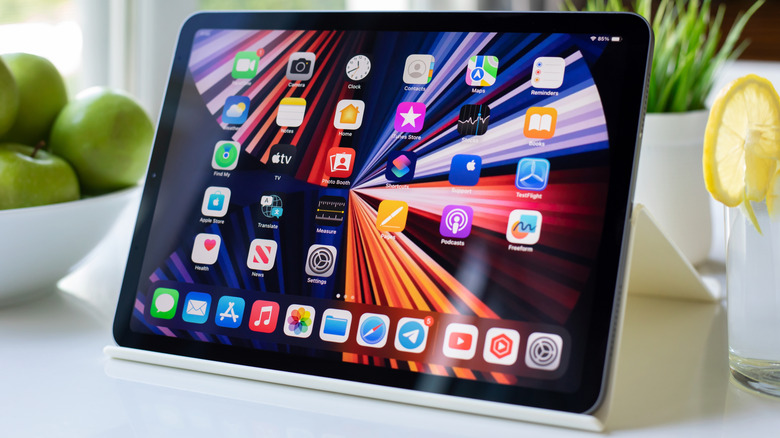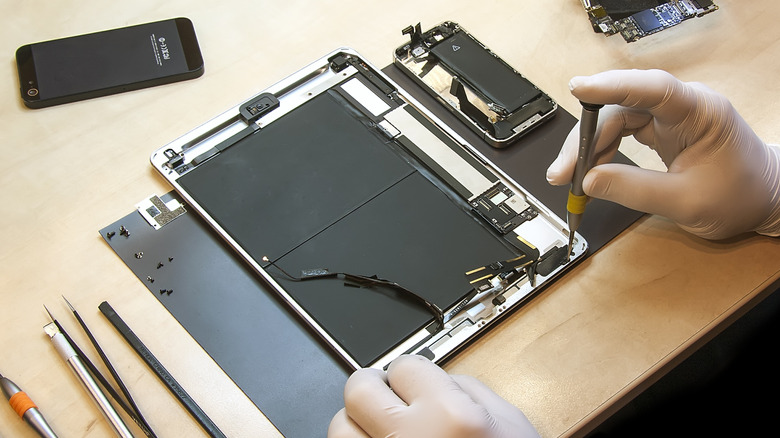Bright Spot On Your iPad Or iPhone Screen? Possible Causes, And What You Can Do
Other than when you've enabled the AssistiveTouch feature on your iPad or iPhone, there shouldn't be a bright spot on your iPad or iPhone screen — one that stays in its place, no matter how much you swipe around or switch between apps or different UI menus. It's a stubborn little issue that many iPhone and iPad users face, especially those who own an older model with an LCD screen, but those with an OLED display aren't entirely safe, either. So, what is the bright spot on your iPad or iPhone? It's a circular patch on your device's screen that's usually brighter than the rest of the display or glows with an unnatural intensity.
While you might not notice these spots when using apps or websites with a light background (especially at lower brightness levels), they become more noticeable in darker areas of the screen and will most definitely show up and annoy you while watching movies, playing video games, or using dark mode. The intensity and size of the spots often depend upon the underlying cause. The good news is that we have a decent idea of what causes the bright spot issue; the bad news is that you may need to spend some money to get rid of it.
What causes the bright spot on your iPhone or iPad screen?
Bright spots on an LCD screen can show up due to several factors, such as backlight bleeding, internal heat from the device's logic board, and external pressure or physical damage to the display. Backlight bleeding is one of the most common causes in old iPads or iPhones. LCD panels on such devices use a backlight to illuminate the pixels, and with constant use over time, the components may degrade, leading to leakage of light from a specific part of the screen, which looks like a bright spot.
When in use, the display on your device heats up and expands, and in a poorly constructed frame, it could push the screen layers against the internal components, resulting in deformation and a bright spot. Consistent overheating of the logic board, due to a faulty power IC, charging circuit, or any other component, can also damage the diffuser or polarizer layers behind the screen, causing bright spots that are noticeably warm to the touch. Last but not least, excessive external pressure (perhaps from something in your backpack) can also cause the issue.
On newer iPhones and iPads with OLED screens, screen burn-in can sometimes look like a bright spot. It happens when the pixels in a specific area — often where static content like app icons or logos is displayed — begin to degrade, leaving a ghost-like impression.
How to get rid of the bright spot on your device?
Unfortunately, there's no DIY fix for this problem. Apple hasn't officially acknowledged the issue, as it's more related to the underlying LCD and OLED technology. Your only option is to get your device inspected to determine whether the damage is covered under the standard warranty for your iPhone or iPad or your AppleCare+ plan (if you have one at all).
If there are no signs of physical damage on your device, Apple might replace the screen free of charge during the warranty period. However, the appearance of a bright spot on the display, along with signs of physical damage (a dent in the chassis, broken glass on the back, or broken screen), is considered accidental damage and only covered if you have an AppleCare+ plan. The plan will help reduce the repair cost, as you're only required to pay a service charge.
If the problem is related to an internal hardware defect, simply repairing or replacing the screen won't be enough, as the bright spot could resurface with time. We recommend having your device professionally evaluated to address both the root cause (a hardware issue) and the symptoms (overheating and the bright spot). If it's a recognized manufacturing defect, Apple might replace your device for free. However, if the issue isn't covered under the one-year warranty and you don't have AppleCare+, you'll be stuck paying out of pocket, which could cost you hundreds of dollars.


